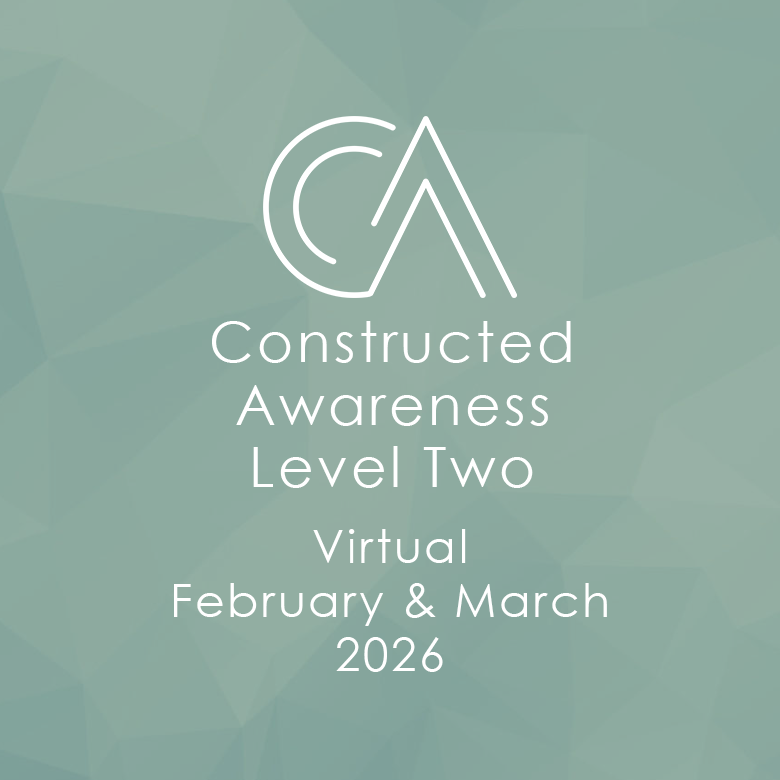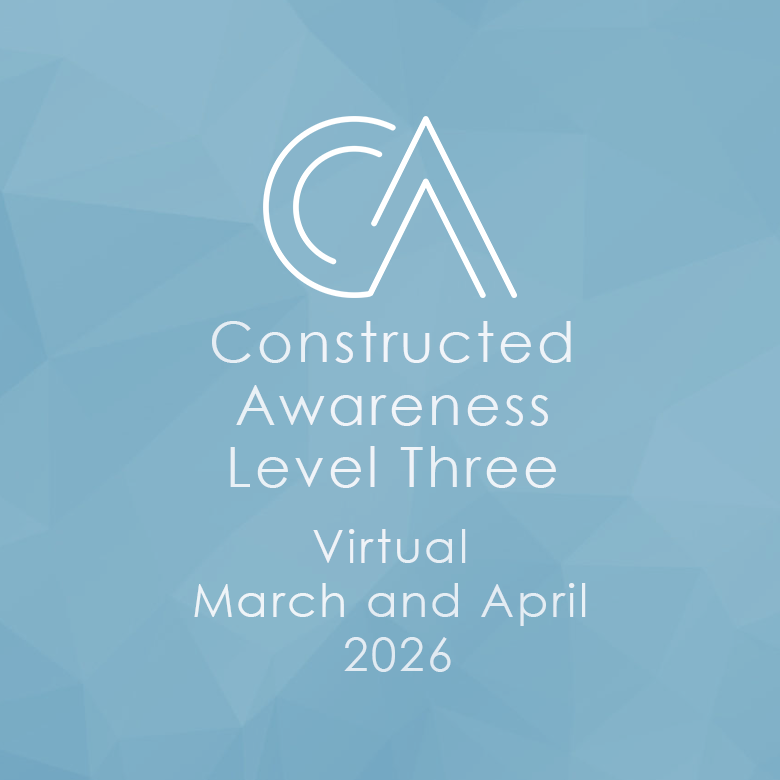
CA Level One
Creating change through deeper awareness
Constructed Awareness level one relies on three simple principles to improve history taking and resourcing. Using concepts such as nonviolence, nonduality, and mindfulness, you will learn an effortless, intuitive approach to therapy that uses awareness as the primary tool to bring about change, rather than willpower. The skills learned in level one will also prepare clients to process trauma and attachment wounds using the methods taught in CA level two or any other process-oriented approach. The CA principles are:
Bringing awareness to the client’s experience changes their experience. If you’re like most, you were brought up with the belief that hard work is the answer to getting what you want. Though this is true for many task-oriented achievements, willpower alone doesn’t work to regulate emotional experiences, despite the fact that many of the more popular approaches to therapy are rooted in this very notion. Inner peace isn’t earned through willpower; rather, it's discovered simply by teaching the client how to observe their inner experience. Observation alone has the power to bring about the change clients are looking for.
The human experience is made up of three building blocks: thoughts, sensations, and external senses. Constructed Awareness teaches a unique practice of bringing mindful awareness to the client’s own experience—an experience that is constructed by thoughts, sensations, and external senses. In the training, we will look at how thoughts, sensation, and external senses make up the entire human experience, especially in regard to how they construct the client’s emotional experiences and interpretations of self, others, and the world. Expanding awareness of how these three building blocks construct the client’s experiences can transform how they regulate and respond emotionally and relationally.
Most people naturally orient their awareness more strongly to one of the three building blocks. By this we mean some people spend more time in their minds analyzing, fantasizing, or planning. Whereas other people direct more attention to sensations and what they feel in their bodies. And some people focus more on what’s happening around them in their external environment. The Constructed Awareness level one training teaches both structured and informal techniques for determining how the client’s awareness is oriented. A typology of six personality types will be taught to help the client understand their personality and character traits based on their orientation style. The training will also cover how to determine which resources would be more useful to deepen self-awareness and the ability to self-regulate based on the client’s specific needs.
This training is a live webinar where participants and the instructor interact together online. Participants meet together on Zoom for four days over the course of two weekends that are usually two weeks apart. Each live session consists of lecture, live and/or video demonstrations, practicum, and group discussion.
This training is an introductory level course. No prerequisites are required.
The level one training qualifies for 30 CE Credit Hours for Psychologists, LCSW's, LMFT's, LCPC's, LMHC's, and substance abuse counselors are available and sold separately through R. Cassidy Seminars. Click here for continuing education information.
Upcoming Trainings

Learning Objectives
Identify two types of resources—regulating resources and information-gathering resources
Demonstrate how the direct awareness of their own experience changes their experience
Define the three building blocks of the client’s conscious experience—thought, sensation, and external senses
Practice using the Constructed Awareness Questionnaire
Identify certain words that offer clues to how the client’s system is oriented
Identify the six orientation types
Describe how emotions are cultural constructions
Demonstrate techniques for tuning and bringing direct awareness to each of the three building blocks of our conscious experience—thought, sensation, and external senses
Identify how their nervous system orients thoughts, sensations, and/or external senses
Identify subtle ways they may be acting or communicating violently with clients
Demonstrate at least one information-gathering resource
Apply nonviolence to working with sensations
Identify certain buffer words that indicate the client may be thinking about what they are feeling or might be feeling rather than directly connecting with sensation
Tell how to bring present-moment awareness to their sense of sound
Tell how to bring present-moment awareness to their sense of sight
Tell how to bring present-moment awareness to their sense of touch
Tell how to bring spontaneous awareness to the client’s experience
Differentiate direct experience of sensation from thoughts
Identify thoughts as words, sounds, and pictures
Apply nonviolence to working with thoughts
Describe how the brain interprets and projects reality
Practice how to perform at least one relational resource
Practice how to perform at least one boundary resource
Agenda
Session 1: The Basic Principles of Constructed Awareness
9:00 – 9:45 Welcome, Introduction, and Awareness Exercise
9:45 – 10:00 What Is Constructed Awareness?
10:00 – 10:45 A Nonviolent Approach to Psychotherapy
10:45 – 11:00 The Transformative Power of Awareness
11:00 – 11:15 Break
11:15 – 11:30 Theory of Constructed Emotion
11:30 – 12:00 What Is an Emotion?
12:00 – 12:30 Are Emotions Real?
12:30 – 12:45 Cultural Construction of Emotions
12:45 – 1:00 Emotion Tracker
1:00 – 2:00 Lunch
2:00 – 2:30 Awareness Exercise and Group Discussion
2:30 – 3:30 Tracking the Orientation of the Client’s Constructed Experience—Using the Constructed Awareness Questionnaire
3:30 – 3:45 Break
3:45 – 5:15 Practicum: Using the Constructed Awareness Questionnaire
5:15 – 5:30 Identifying Self-Awareness Resources Based on the Client’s Needs
5:30 – 6:00 Group Discussion
Session 2: Awareness of the Internal and External Senses
9:00 – 10:00 Group Discussion and Awareness Exercise
10:00 – 11:30 Awareness of Senses
11:30 – 11:45 Break
11:45 – 12:15 Talking with Your Hands
12:15 – 1:00 Tuning Sensation—Pendulation
1:00 – 2:00 Lunch
2:00 – 2:30 Awareness Exercise and Group Discussion
2:30 – 3:15 Tuning Senses and Sensation—Orienting
3:15 – 3:30 Break
3:30 – 5:30 Practicum
5:30 – 6:00 Group Discussion
Session 3: Awareness of Thoughts
9:00 – 10:00 Group Discussion and Awareness Exercise
10:00 – 11:15 Review of CAQ and Emotion Tracker
11:15 – 11:30 Break
11:30 – 1:00 What is a Thought?
1:00 – 2:00 Lunch
2:00 – 2:30 The Interpreter
2:30 – 3:00 Group Discussion and Awareness Exercise
3:00 – 3:15 Expressing Actual Affirmations
3:15 – 3:30 Break
3:30 – 5:30 Practicum: Observing Thoughts
5:30 – 6:00 Group Discussion and Closing
Session 4: Relational Resources and Constructing Emotions
9:00 – 10:00 Group Discussion and Awareness Exercise
10:00 – 11:15 The Construction of Connection
11:15 – 11:30 Break
11:30 – 1:00 Practicum: Relational Resources
1:00 – 2:00 Lunch
2:00 – 2:30 Group Discussion and Awareness Exercise
2:30 – 3:00 Tuning Thought, Sensation, and Senses—Constructing Emotions
3:00 – 3:15 Spontaneous Resourcing/Processing
3:15 – 3:30 Break
3:30 – 5:30 Practicum: Constructing Emotions and Spontaneous Resourcing/Processing
5:30 – 6:00 Group Discussion and Closing




